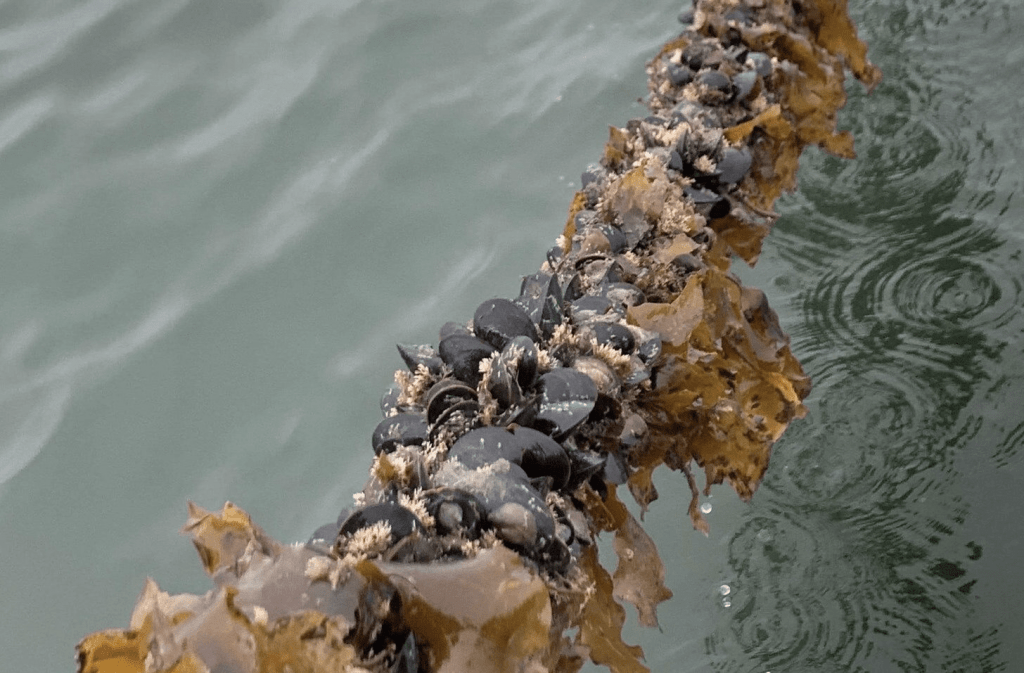by Jessica Carstens-Kass
In anticipation of a boom in the still-nascent industry of American ocean farming (aquaculture), Holdfast Aquaculture is setting a precedent for sustainable and science-based farming practices.
The small company runs its commercial and research operations at AltaSea at the Port of Los Angeles, a public-private collaborative ocean institute in San Pedro, California. On the commercial side, Holdfast produces California-native seaweed and shellfish seeds for purchase by seaweed farmers who grow the seafood and sell it to restaurants. On the research side, Holdfast is developing novel aquaculture techniques for mussels, including introducing new California-native species to provide to local farmers and optimizing the taste of these species.
Unlike agriculture, aquaculture does not require land, freshwater, fertilizer, or other chemicals – the ocean naturally provides everything the farmed organisms require to flourish, resulting in a highly sustainable and healthy food source. Shellfish are one of the most environmentally friendly sources of protein on the planet, and along with seaweeds contain essential vitamins, fatty acids, and minerals.
And, besides being a nutritious and more sustainable method for feeding the world than land-based farming, aquaculture also actively improves the health of our oceans. Positioned at the bottom of the food chain, seaweeds photosynthesize energy from sunlight into sugar and biomass, supporting vital marine ecosystems. A single shellfish can filter nitrogen and particulate waste out of approximately fifty gallons of seawater every day [1]. Excess nitrogen is the root cause of marine “dead zones,” where imbalanced nutrients promote the growth of harmful algal blooms, which then block sunlight from reaching photosynthesizing organisms below the surface [2]. By removing nitrogen from seawater, shellfish prevent harmful algal blooms from flourishing.
Particulate waste filtered by shellfish includes dust, dirt, and also anthropogenic waste such as plastic debris [3]. An estimated 8,300 million metric tons of plastics have been produced since large-scale plastics manufacturing began around 1950. Rather than being properly disposed of by recycling or incineration, 79% of plastics are improperly discarded (e.g., sent to landfills, flushed down drains, littered) and seep into the soil, rivers, and lakes, ultimately reaching the oceans. While plastics do not biodegrade, they do break down over time due to ultraviolet radiation from the sun and being tumbled by the ocean, resulting in meso-, micro-, and nano-plastics (5-50 mm, 0.0001-5 mm, <0.0001 mm, respectively). Shellfish filter microplastics from water [4]; using the existing infrastructure designed to grow shellfish for seafood restaurants, Holdfast’s ocean farming clientele have an opportunity to grow shellfish specifically for monitoring ocean microplastic levels. Shellfish also filter valuable rare earth elements from seawater [5], providing yet another opportunity to capitalize off of the ocean farming industry that Holdfast supports.
Another way aquaculture improves ocean health is by promoting the restoration of biodiversity that has been lost due to anthropogenic stressors including climate change. Professional aquaculturist and former commercial fisherman Bren Smith has stated, “My farm used to be a barren patch of ocean, and now it’s a thriving ecosystem” [6]. By providing sustainably sourced seeds to ocean farmers and improving aquaculture methodology through cutting-edge research and development, Holdfast Aquaculture is rightfully setting a high bar for the level of sustainability one can expect from the fast-growing aquaculture industry in the Los Angeles area, the United States, and the rest of the world.
- Holdfast Aquaculture. https://www.holdfastaq.com/solutions.
- Dead Zone. National Geographic. https://education.nationalgeographic.org/resource/dead-zone.
- Cartwright, Peter S. Particulate Pollution: What’s in Your Ocean? Water Conditioning and Purification International Magazine. https://wcponline.com/2018/10/15/particulate-pollution-whats-ocean/.
- Ringwood, Amy Huffman. Bivalves as Biological Sieves: Bioreactivity Pathways of Microplastics and Nanoplastics. University of Chicago Press Journals. https://www.journals.uchicago.edu/doi/full/10.1086/716259.
- Zhao P et al. Rare earth elements in oysters and mussels collected from the Chinese coast: Bioaccumulation and human health risks. Marine Pollution Bulletin. https://www.sciencedirect.com/science/article/pii/S0025326X22008098.
- Bren Smith’s Open-Sourced 3D Ocean Farm Model Can Feed a Hungry Planet. Bioneers. https://bioneers.org/bren-smiths-open-sourced-3d-ocean-farm-model-can-feed-hungry-planet-ztvz1709/.
- GreenWave @GreenWaveOrg, Twitter.
Jessica is part of the 2022 INFEWS cohort and a PhD student in Molecular, Cell, and Developmental Biology at UCLA. Her research focuses on molecular strategies to protect and utilize giant kelp forests in the fight against climate change.
The blog is part of the INFEWS Social Media Series and the 2022 Field Lab

